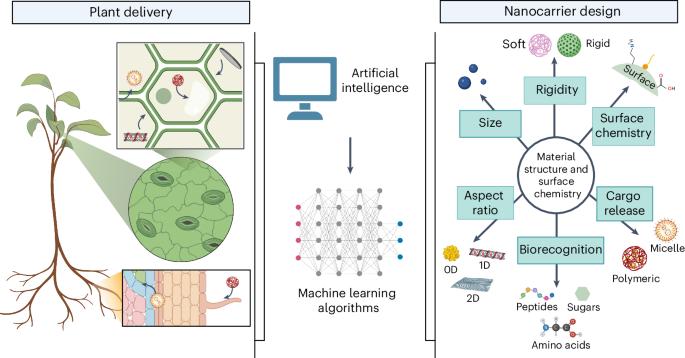实现植物纳米精准输送
IF 38.1
1区 材料科学
Q1 MATERIALS SCIENCE, MULTIDISCIPLINARY
引用次数: 0
摘要
纳米载体(NC)可以将活性剂、营养物质和遗传物质精确地输送到植物体内,这将使作物农业更能适应气候变化,并具有可持续性。作为一个研究领域,纳米农业仍在发展之中,需要克服巨大的科学和社会障碍。在本综述中,我们认为可以从哺乳动物纳米医学中吸取经验教训。特别是,通过更好地了解数控特性如何影响它们与植物表面和生物分子的相互作用,以及它们携带和运送货物到特定位置的能力,有可能提高效率和功效。我们需要新的工具来快速评估数控系统与植物之间的相互作用,并探索和验证一系列可行的植物靶向方法。阐明这些相互作用可以创建计算机生成的硅学模型(数字双胞胎),以预测不同数控系统和植物特性、生物反应和环境条件对纳米技术方法的效率和功效的影响。最后,我们强调纳米农业研究人员和社会科学家有必要联合起来,共同开发可持续、安全和社会可接受的数控技术。本文章由计算机程序翻译,如有差异,请以英文原文为准。


Towards realizing nano-enabled precision delivery in plants
Nanocarriers (NCs) that can precisely deliver active agents, nutrients and genetic materials into plants will make crop agriculture more resilient to climate change and sustainable. As a research field, nano-agriculture is still developing, with significant scientific and societal barriers to overcome. In this Review, we argue that lessons can be learned from mammalian nanomedicine. In particular, it may be possible to enhance efficiency and efficacy by improving our understanding of how NC properties affect their interactions with plant surfaces and biomolecules, and their ability to carry and deliver cargo to specific locations. New tools are required to rapidly assess NC–plant interactions and to explore and verify the range of viable targeting approaches in plants. Elucidating these interactions can lead to the creation of computer-generated in silico models (digital twins) to predict the impact of different NC and plant properties, biological responses, and environmental conditions on the efficiency and efficacy of nanotechnology approaches. Finally, we highlight the need for nano-agriculture researchers and social scientists to converge in order to develop sustainable, safe and socially acceptable NCs. Nanocarrier delivery has huge potential in agriculture; however, there are significant scientific and societal barriers to overcome. In this Review, the authors explore the state of the field, what lessons can be learned from nanomedicine, and discuss what scientific and societal issues need to be addressed.
求助全文
通过发布文献求助,成功后即可免费获取论文全文。
去求助
来源期刊

Nature nanotechnology
工程技术-材料科学:综合
CiteScore
59.70
自引率
0.80%
发文量
196
审稿时长
4-8 weeks
期刊介绍:
Nature Nanotechnology is a prestigious journal that publishes high-quality papers in various areas of nanoscience and nanotechnology. The journal focuses on the design, characterization, and production of structures, devices, and systems that manipulate and control materials at atomic, molecular, and macromolecular scales. It encompasses both bottom-up and top-down approaches, as well as their combinations.
Furthermore, Nature Nanotechnology fosters the exchange of ideas among researchers from diverse disciplines such as chemistry, physics, material science, biomedical research, engineering, and more. It promotes collaboration at the forefront of this multidisciplinary field. The journal covers a wide range of topics, from fundamental research in physics, chemistry, and biology, including computational work and simulations, to the development of innovative devices and technologies for various industrial sectors such as information technology, medicine, manufacturing, high-performance materials, energy, and environmental technologies. It includes coverage of organic, inorganic, and hybrid materials.
 求助内容:
求助内容: 应助结果提醒方式:
应助结果提醒方式:


